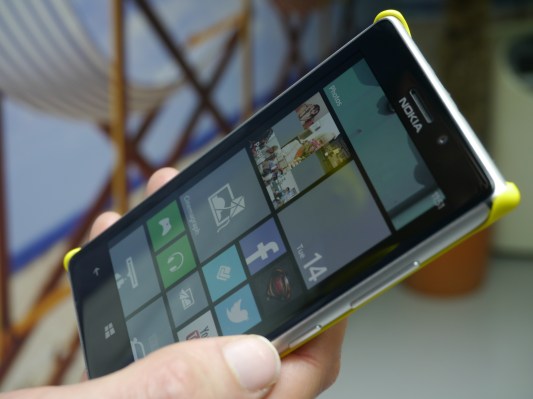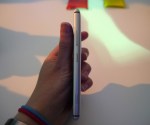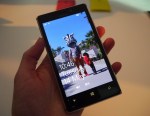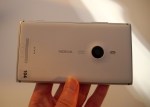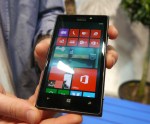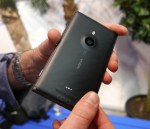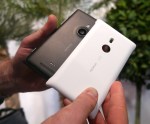Meet the Lumia 925, the latest smartphone flagship in Nokia’s increasingly populous Windows Phone portfolio. The 925 is clearly Nokia’s answer to criticisms of its high end devices being too heavy. At the device’s London launch earlier today, Vodafone’s Patrick Chomet – brought onstage to talk up the new Lumia which the carrier will be ranging in Europe — couldn’t avoid commenting negatively on the Lumia 920’s weight. For all the noise about the 925’s camera, its less hefty hardware is the key design difference here.
The 925 drops a full 46g compared to the earlier Lumia 920, weighing in at 139g vs the 920’s hefty 185g. The phone feels pleasingly light in the hand, helped by its slender profile: it’s just 8.5mm thick at its thickest point (vs 10.7mm for the 920). In order to achieve a sleeker, lighter device, yet keep the 4.5-inch display, Nokia has dropped built-in wireless charging – but it’s not ditching the tech entirely. It has included wireless charging as an add-on via clip-on shells – likely sold separately — which increase the thickness of the 925 by a few millimetres but don’t appear to add too much weight back on.
It’s a compromise but one that results in a sleeker, more attractive handset out of the box. If it’s a choice between wireless charging – which remains something of a gimmick — or a lightweight phone, most people would opt for the latter. And that’s a calculation Nokia has clearly made with the 925.
The handset design also takes a few steps in a new direction for the Lumia range, with aluminium edging running around its four sides – a band which doubles as the phone’s antenna – coupled with a polycarbonate back. The two-tone look and feel is a definite departure for Nokia’s high end phone design. Colour options are also more subtle, with the black version having anodized, almost charcoal looking aluminium edging, while the white 925 has silver edges. There’s also a grey colourway. The trademark bright Lumia colours are reserved for the wireless charging shells — including red, yellow and cyan.
The PureView-branded 8.7MP camera on the 925 is the other big focus here. The hardware introduces a sixth lens to the device, which Nokia says improves performance in bright sunlight. This is in addition to strong low-light capabilities, which it has touted on its other Lumia flagships – including most recently the Lumia 928.
During the 925 launch Nokia demoed both the low and bright-light photography capabilities of the phone, inviting the press to compare the shots with photos taken on their own smartphones. The Lumia 925 came off as better at snapping in the dark than iPhones, the BlackBerry Z10, the HTC One and even the Lumia 920, pulling a brighter, more colourful image from out of the gloom. It also appeared to capture more detail in strong light conditions in Nokia’s test conditions.
As well as the extra hardware lens, the 925 includes a new suite of camera-editing software called Nokia Smart Camera. This makes use of a burst mode that takes 10 photos at around 5MP each. It then offers a series of image-manipulation options to enhance the photo. Some of these features were a little hit and miss under the press launch lighting conditions. Others looked a little gimmicky, such as the ability to composite a series of movements into one shot. But others seemed like they could be genuinely useful, such as a feature that allows you to create the best shot by choosing from various facial expressions — much like the timeshift feature on the BlackBerry Z10/Q10. Or another that lets you remove a moving object from an image, such as a person or car passing in front of the scene you’re trying to shoot.
The Smart Camera software won’t be exclusive to the Lumia 925 for long – Nokia said it will be pushed out to other Nokia Lumia Windows Phone 8 devices as an update in Q3. But for the moment, the Lumia 925 has the lion’s share of Nokia’s camera creativity, including some new features in its Creative Studio image editing app, such as a tilt shift and radial focus. And the Oggl app.
One more new software addition in the 925’s screen settings allows users to tweak the colour saturation and temperature of the AMOLED screen to dial down how poppingly bright the colours are and opt for more muted, photo-realistic tones if you desire. Elsewhere, this is a business-as-usual Windows Phone 8 device loaded with the usual suite of Microsoft and Nokia apps, which include its HERE mapping and location apps and Nokia Music. It is also skinned with the new more flexible Windows Phone homescreen that allows for three different-sized live tiles.
The 1.5GHz dual-core Snapdragon chip powering the Lumia 925 doesn’t sound that beefy, considering the proliferation of quad-core phones in the Android ecosystem at least, but it’s as top-of-the range as Windows Phone gets right now. And Nokia argues that no more processing clout is required to do all of the image processing going on under the 925’s hood.
